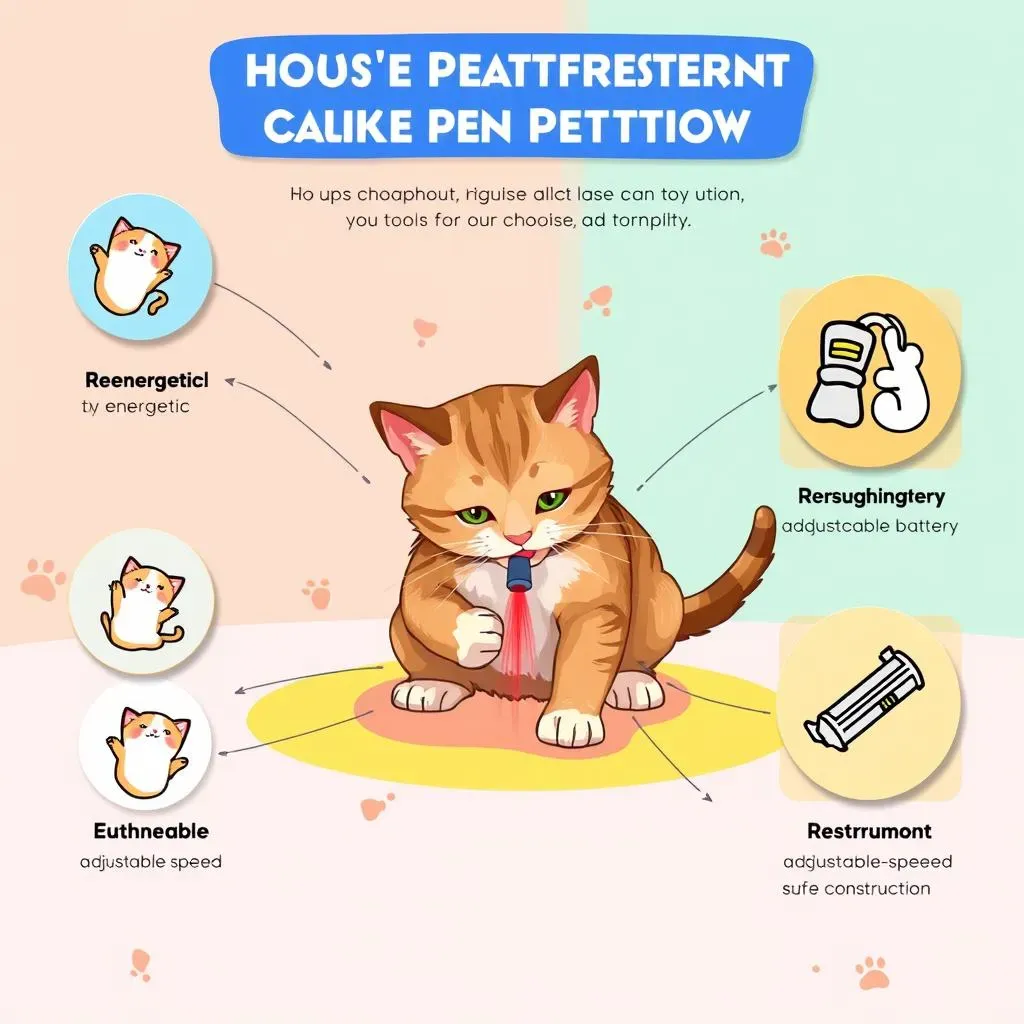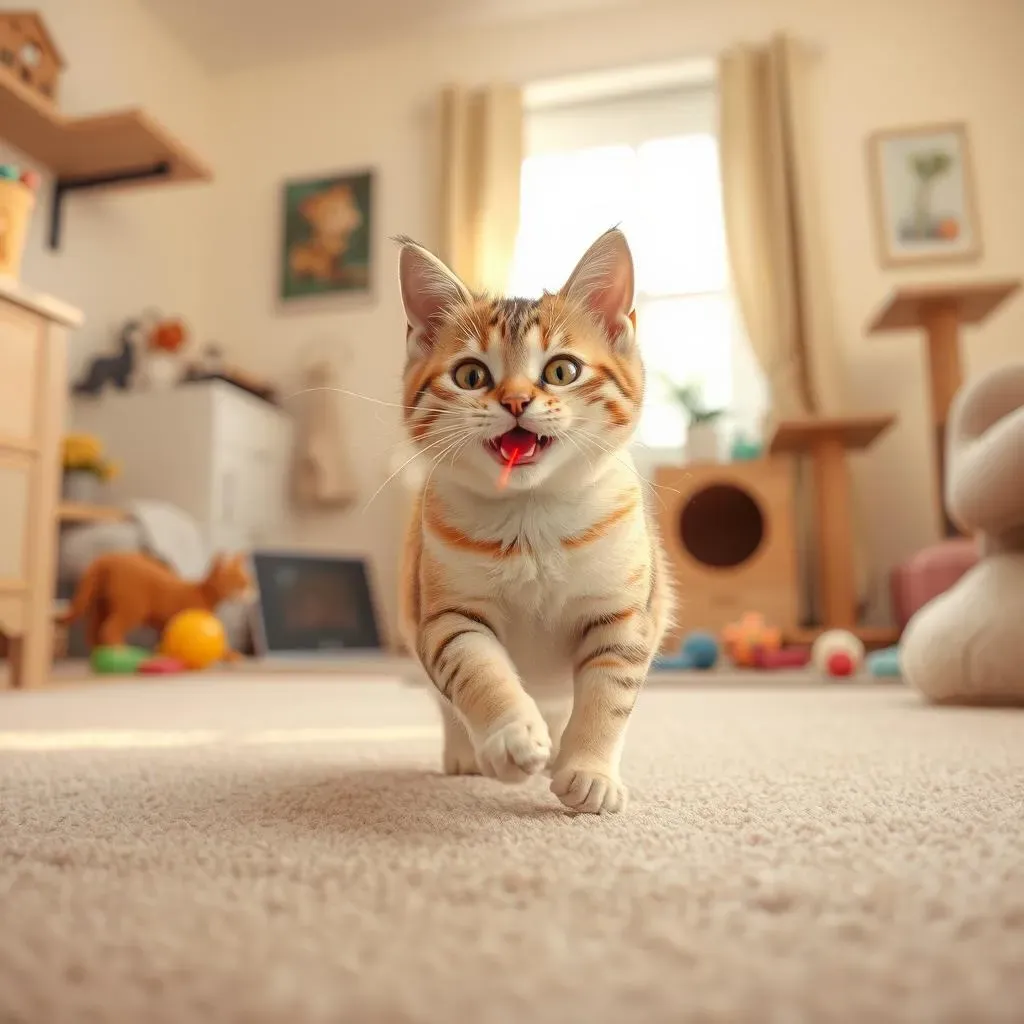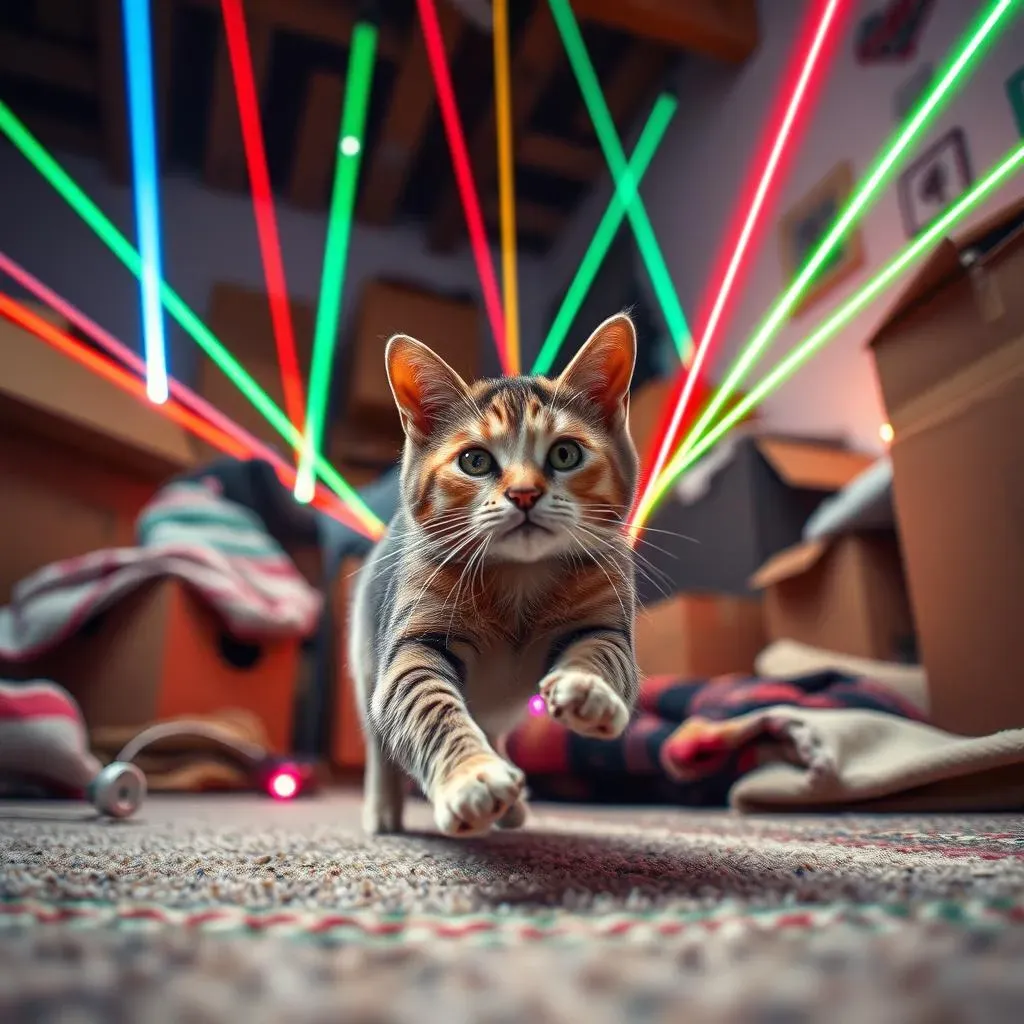Table of Contents
Is your feline friend bored with their usual toys? Do you want to engage them in a fun and exciting way that also provides some exercise? Then get ready to discover the world of the cat laser pen toy! This comprehensive guide will walk you through everything you need to know about this popular interactive toy. We'll help you select the perfect cat laser pen toy for your cat's personality and needs, ensuring safe and stimulating playtime. Learn how to create engaging games that go beyond simple chasing, strengthening your bond with your furry friend. We'll even tackle common problems and offer solutions, so you can avoid potential pitfalls and maximize the fun. Get ready to unleash a world of playful excitement with your cat and their new favorite toy – the cat laser pen toy. Prepare for a purr-fectly entertaining journey!
Choosing the Right Cat Laser Pen Toy

Choosing the Right Cat Laser Pen Toy
Consider Your Cat's Personality
Picking the right cat laser pen toy isn't just about finding a flashy light; it's about understanding your cat's unique personality. Some cats are energetic hunters, diving into playtime with gusto. Others are more laid-back, preferring a gentle, less intense experience. For high-energy cats, a laser with multiple patterns or adjustable speeds might be ideal, keeping them engaged and challenged. More relaxed cats might prefer a simpler, single-dot laser with a slower movement.
Think about your cat's hunting style. Do they stalk their prey slowly or pounce with lightning speed? A laser with a fast, erratic beam might be perfect for a quick-thinking hunter, while a slower, more predictable beam might suit a more methodical cat. Remember, the goal is to match the toy's characteristics to your cat's natural hunting instincts. It’s all about finding that perfect balance between stimulation and stress-free fun.
Cat Personality | Recommended Laser Type |
|---|---|
High-energy, playful | Multiple patterns, adjustable speed |
Calm, relaxed | Simple single dot, slow movement |
Curious, investigative | Laser with varied light patterns |
Features to Look For in a Cat Laser Pen Toy
Beyond your cat's personality, certain features can significantly improve the playtime experience. A rechargeable battery is a must; constantly replacing batteries is a hassle. Look for lasers with a decent range – you want to be able to engage your cat from a comfortable distance without them getting too frustrated. Some lasers offer different modes, such as a continuous beam or a pulsating one. This variety can keep your cat interested and prevent boredom. Also, consider the size and shape of the laser pointer itself. A smaller, pen-like design is often easier to handle and maneuver during playtime.
Safety is paramount. Always choose a laser pen that's specifically designed for pet use. Some lasers might emit light that's harmful to your cat's eyes, so ensure you're purchasing from a reputable brand. Also, be aware of the laser's power; a low-powered laser is generally safer and more appropriate for playtime. Don't forget, you are responsible for your cat's safety and well-being. Choosing a quality laser toy is a crucial part of this responsibility.
- Rechargeable battery
- Good range
- Multiple play modes (if desired)
- Ergonomic design
- Pet-safe construction
Safe and Engaging Playtime with Your Cat Laser Pen Toy

Safe and Engaging Playtime with Your Cat Laser Pen Toy
Setting the Stage for Safe Laser Play
Think of your cat's playtime with a laser pointer like a carefully choreographed dance. It’s not just about the flashy light; it's about creating a fun, safe, and mentally stimulating experience. First, choose a well-lit area. This helps your cat track the laser beam more easily and prevents eye strain. Avoid playing near reflective surfaces like mirrors or windows, as the reflected light can disorient your cat and possibly cause them stress. Always end the session with a "catch." This means directing the laser onto a tangible toy or treat, satisfying your cat's hunting instinct and preventing frustration.
Remember, a laser pointer shouldn't be the *only* toy. It's a fantastic tool for engaging your cat but should be part of a larger repertoire of toys. Think of it as a high-energy treat, not a meal. Overuse can lead to frustration and obsession. Always offer alternative toys, especially those that allow your cat to successfully "catch" their prey, providing a sense of accomplishment. This prevents the build-up of frustration from never quite catching the elusive laser dot.
Safe Play Environment | Tips |
|---|---|
Lighting | Well-lit area to aid tracking |
Surfaces | Avoid reflective surfaces |
Ending the Play Session | Always end with a "catch" |
Keeping Playtime Fun and Varied
Variety is the spice of life, even for cats! To keep your cat engaged and prevent boredom, change up your laser pointer games. Try varying the speed and direction of the laser, creating different patterns and challenges. You can even incorporate other toys, such as a feather wand or a toy mouse, to make the game more interactive. Don't just stick to the floor; let the laser "hunt" across walls and even the ceiling—it is a cat's world after all. Remember, the key is to keep your cat mentally stimulated and physically active. A little creativity can go a long way in keeping the play session exciting.
Always supervise your cat during laser playtime. Never point the laser at their eyes, and always ensure the laser is turned off when not in use. Regularly assess your cat's body language. If they seem stressed or frustrated, take a break. Playtime should be fun for both of you. If your cat starts exhibiting signs of aggression or excessive chasing, it's a sign to end the play session. A tired, happy cat is a sign of a successful play session.
- Vary speed and direction
- Incorporate other toys
- Play on different surfaces
- Supervise playtime closely
- Observe your cat's body language
Beyond the Chase: Creative Cat Laser Pen Toy Games

Beyond the Chase: Creative Cat Laser Pen Toy Games
Beyond the Simple Chase: Elevating Your Cat's Laser Play
Let's face it: simply chasing a red dot can get old, even for the most enthusiastic feline. To keep your cat engaged and mentally stimulated, you need to think outside the box (or, in this case, outside the laser beam!). The key is to transform laser playtime from a simple chase into a more complex and rewarding experience. Think of it as adding levels to a video game; each new challenge keeps your cat coming back for more. We're not just talking about moving the laser faster or slower; we're talking about strategic gameplay designed to challenge your cat's hunting instincts in new and exciting ways.
One simple upgrade is to introduce obstacles. Hide the laser behind objects, making your cat work to find and track the beam. This adds an element of problem-solving to the game, making it far more engaging than a simple, straightforward chase. You can use household items like pillows, blankets, or even cardboard boxes to create a mini-obstacle course for your laser pointer. The more challenging you make it, the more your cat will enjoy the mental stimulation. Remember, cats are natural hunters; they love a good challenge.
Game Enhancement | Description |
|---|---|
Obstacle Course | Use household items to create a challenging path for the laser. |
Hidden Targets | Hide the laser behind objects, requiring your cat to search and track. |
Multi-Laser Play | Use multiple laser pointers (with supervision) for a more complex game. |
Another fun way to spice things up is incorporating other toys into the laser game. Imagine this: the laser leads your cat towards a toy mouse, creating a thrilling climax to the hunt. This provides a satisfying "catch" and reinforces positive behavior. You can also use a wand toy to mimic the laser's movements, allowing your cat to switch between chasing the light and batting at a tangible toy. This keeps them entertained and prevents them from getting fixated solely on the laser. The possibilities are endless; use your creativity to keep your cat on their toes!
Remember, the goal is to create a stimulating and rewarding experience for your cat. By adding complexity and variety to your laser playtime, you're not just providing entertainment; you're strengthening your bond with your feline friend and ensuring they get the mental and physical exercise they need. So, ditch the simple chase and unleash your creativity; your cat will thank you for it! And who knows, you might even discover a hidden talent for feline game design.
- Combine laser with other toys (e.g., toy mouse)
- Use a wand toy to mimic laser movements
- Create a "treasure hunt" with the laser leading to treats
- Vary the surfaces the laser is projected onto (walls, ceiling)
Troubleshooting Common Cat Laser Pen Toy Issues

Troubleshooting Common Cat Laser Pen Toy Issues
My Cat's Not Interested!
Sometimes, despite your best efforts, your cat might seem uninterested in the laser pointer. This isn't necessarily a reflection on your cat's personality or your laser-pointer skills. It could be as simple as the wrong time of day or a lack of sufficient stimulation. Try playing at different times, perhaps when your cat is more alert and active. Also, consider varying the environment. A new location might spark their interest. If your cat is already engaged in another activity, it might be best to let them finish before attempting to play with the laser.
Another possibility is that the laser light itself isn't captivating enough. Try changing the speed and pattern of the laser beam, or even the color if your laser pointer allows it. Some cats are more drawn to certain patterns or speeds. If your cat still seems uninterested, try incorporating other toys into the game, such as a feather wand or a toy mouse, to add variety and make the experience more engaging. Remember, even the most enthusiastic hunter needs a break sometimes.
Problem | Possible Solution |
|---|---|
Cat is uninterested | Try different times of day, locations, or patterns. |
Cat is easily distracted | Minimize distractions and create a focused play environment. |
Cat is bored | Incorporate new toys or games into the laser playtime. |
My Cat's Obsessed!
While a healthy interest in the laser pointer is great, an obsession can be a problem. If your cat becomes fixated on the laser to the point of neglecting other activities, food, or even you, it's time for an intervention. The key is to gradually reduce the laser playtime, introducing alternative toys and activities. Remember, a laser pointer is a tool for enriching playtime, not a replacement for other forms of interaction. Try gradually decreasing the duration of laser play sessions, and ensure you're incorporating other types of play into your cat's routine. This helps maintain a balance and prevents over-reliance on the laser.
It's also crucial to ensure the laser sessions always end with a "catch," allowing your cat a feeling of success and fulfillment. This helps prevent frustration and reinforces positive behavior. If you notice signs of stress, such as excessive panting or flattened ears, it’s time to end the session immediately. Remember, playtime should be fun and rewarding, not a source of anxiety. If the obsession persists, consider consulting with a veterinarian or a certified cat behaviorist for further guidance.
- Gradually reduce laser playtime duration
- Introduce alternative toys and activities
- Always end sessions with a "catch"
- Monitor your cat's body language for signs of stress
- Consult a professional if necessary
The Laser is Malfunctioning!
Sometimes, the problem isn't your cat; it's the laser pointer itself. If the laser isn't working correctly, it can lead to frustration for both you and your feline friend. First, check the batteries. A weak battery can cause the laser to be dim or intermittent, making it difficult for your cat to track. If the batteries are fine, examine the laser pointer itself for any visible damage. A cracked lens or a loose connection could be the culprit. If you suspect a manufacturing defect, contact the manufacturer or retailer for a replacement or repair. Don't attempt to fix the laser yourself unless you are experienced with electronics.
Finally, remember that even a perfectly functioning laser pointer has a limited lifespan. The laser diode, the component that produces the light, will eventually wear out. If your laser pointer is old, it might be time for a replacement. Choosing a high-quality laser pointer from a reputable brand can help extend its lifespan and minimize the risk of malfunctions. Investing in a good laser pointer is an investment in your cat's happiness and playtime.